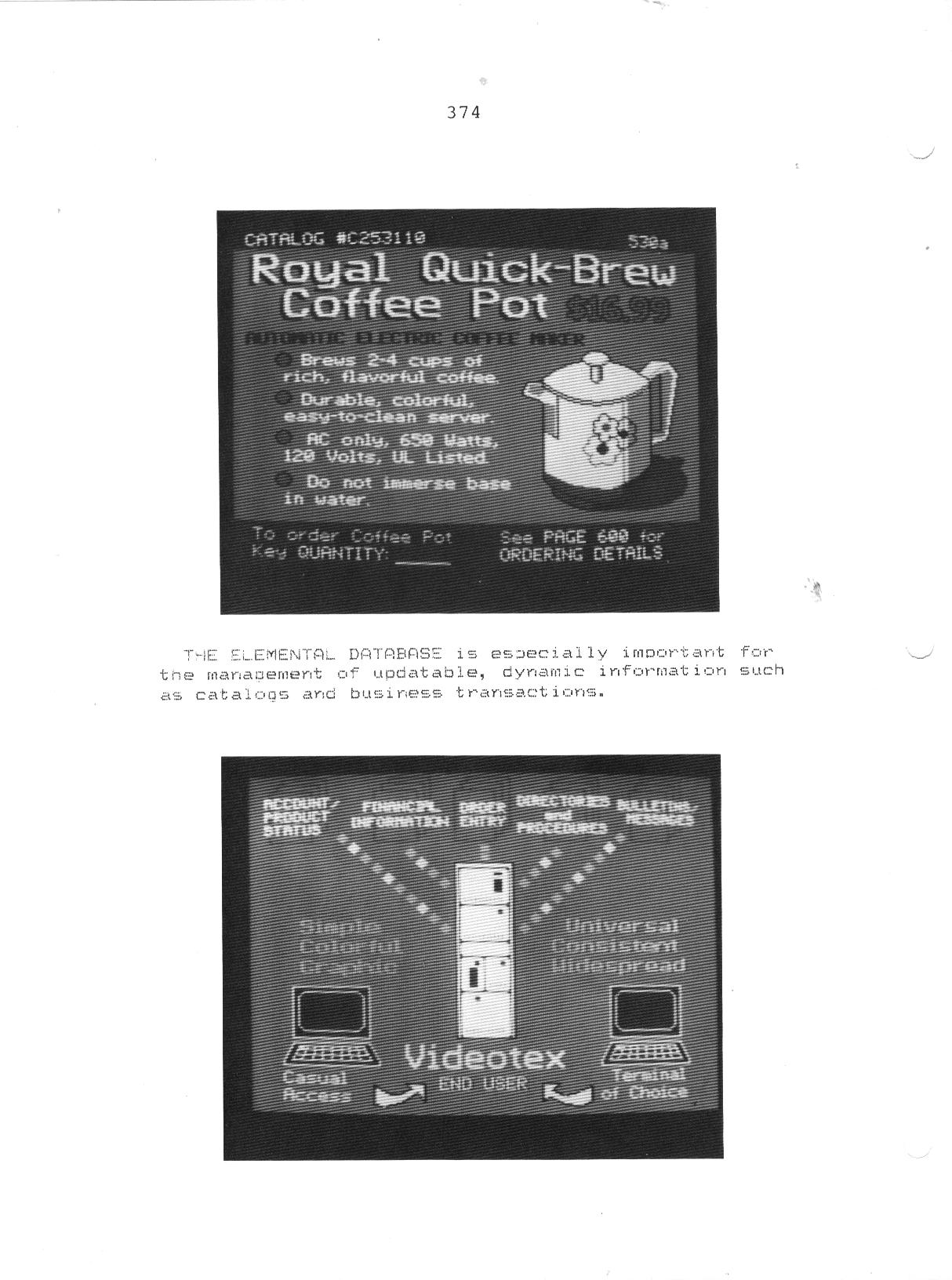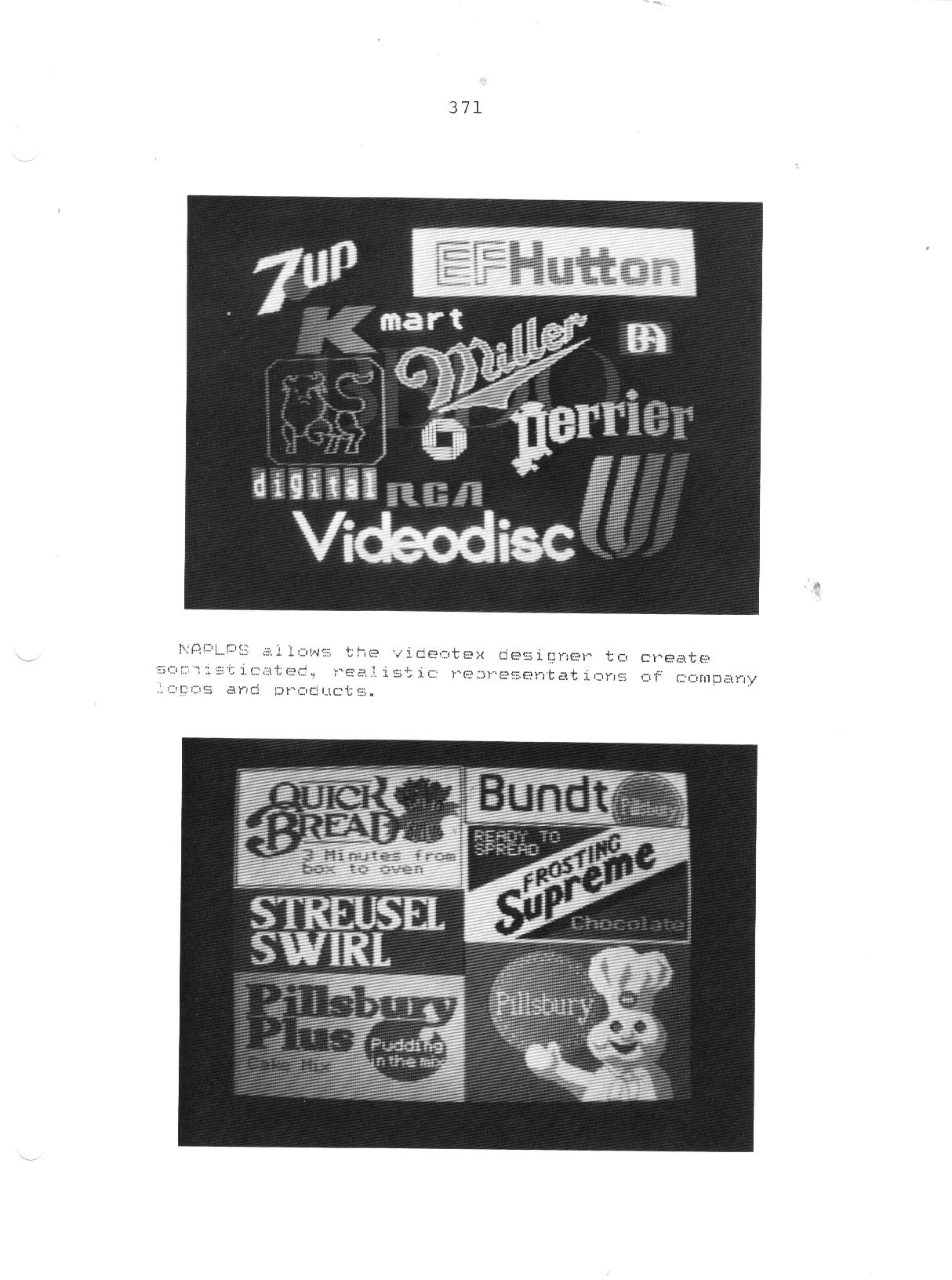Interactive Architecture
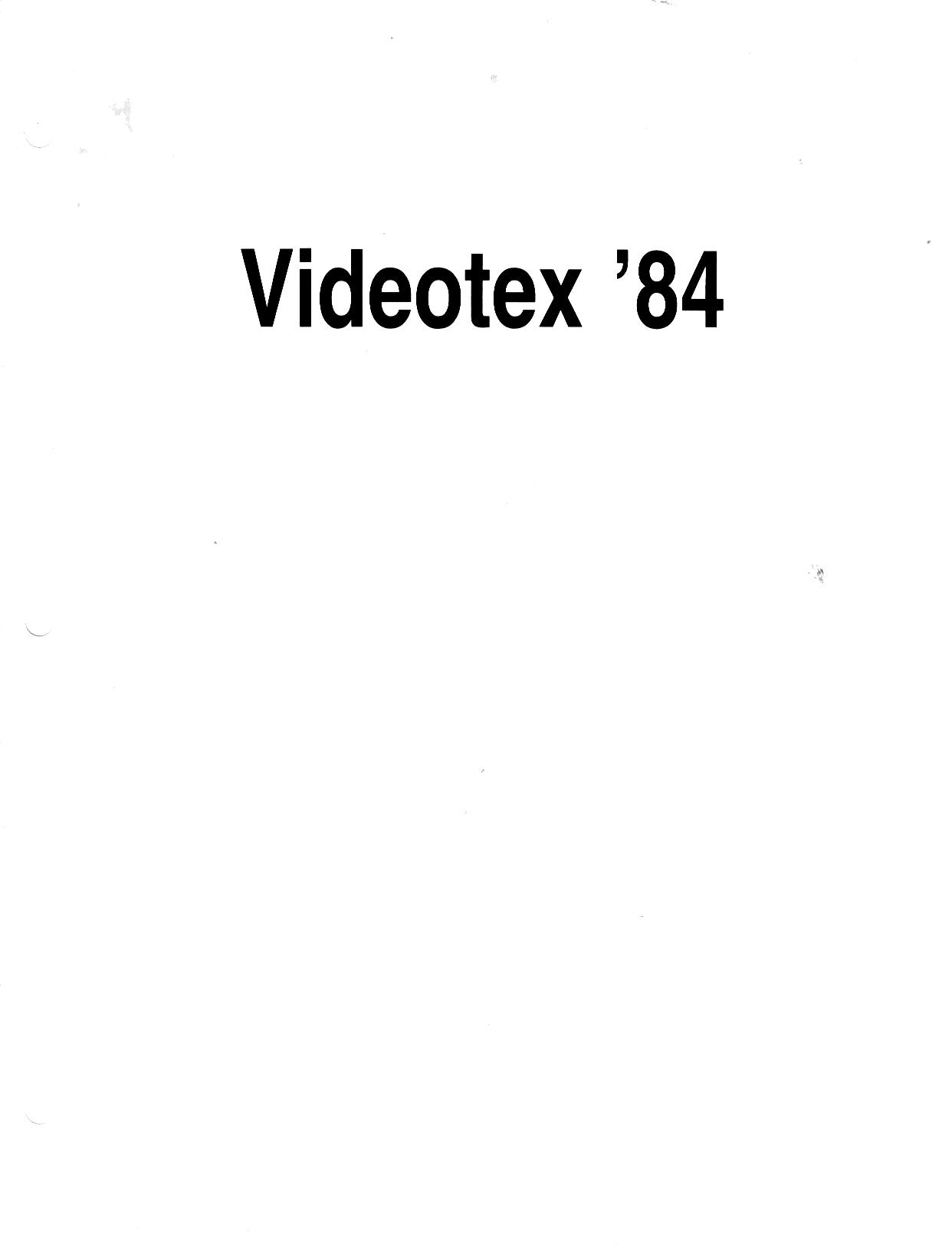
Presented at Videotex '84 conference (Before we Called it the Web).
The existing descriptors are Transactional, Publishing and Visual Design. The new metaphor is "Interactive Architecture". The new model is the Information Community.
We now have "the emerging role of the Interactive Architect". This holistic view implies a new set of markets, skills, tools and techniques, including:
- "Windowed" environments
- Standard Symbology
- Metadata Tagging
Note: Produced on a dot matrix printer. Classic.
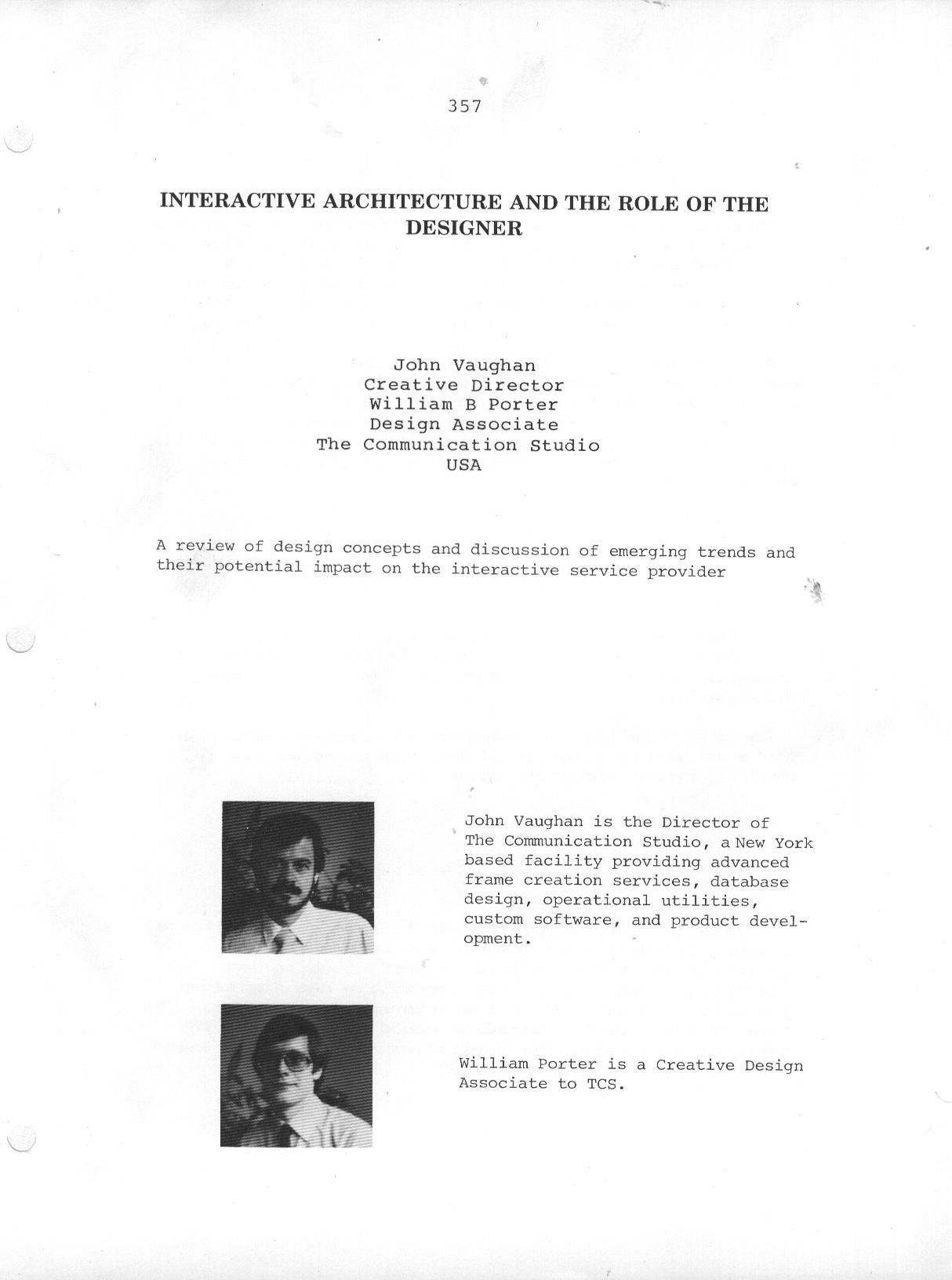
Intro
This may be the first time that there has ever been a session at a conference devoted exclusively to Videotex Frame Design, so let's take a closer look at this emerging roe. If the attendance in this room is any indication, Videotex Frame Design would seem to be emerging as a real Job description in the industry.
As more and more interactive services come on-line over the next decade, it is the Videotex Frame Designer who will put the finishing touches on the face of the product. Furthermore the competitive edge among services will be determined in large dart by the skill, talent, and effective coordination of the videotex design staff.
Metaphors for a New Medium
At times it seems that there is a substantial discontinuity between the "form" of NAPLPS screen presentation and the interactive "function" of the database structure.
Perhaps this lack of integration between content and style is partly a result of the metaphors we use in describing tne videotex industry.
Videotex as Publishing
Initially videotex design was treated as an editorial issue. It dealt with the content of the screen primarily as text on static "pages" bound in an electronic "magazine". This perception has dominated the early development of the interactive industry. The form of the videotex database could be described in terms of a LiPrary. The publishing metaphor sees the Videotex Designer as an EDITOR
Videotex as Transaction
With the increasing involvement of the banking community and retail stores, systems operators have begun to look at videotex systems more as information processors rather than as simple information retrieval services. This perception has encouraged more dynamic database design and has resulted in the emergance of downloaded software, intelligent terminals and games as a real vidotex service. At this level of sophistication the videotex database might be described as information Processing. The transactional metaphor sees the Videotex Designer as a PROGRAMMER.
Videotex as Visual Medium
As videotex matures, system operators and IPs are investing larger sums in the pursuit of the ever elusive "user friendly interface". This means there wl:.1 be an increasing emphasis upon videotex design as a ores,entational display. Here the information is seen primarily as a graphic issue: what might be described as the "Face of the Interface". The visual Metabhor sees the videotex database as a filmic/graphic oresefitation vehicle. The Visual Metaphor sees the Videotex Designer as an ARTIST.
Towards an Integrated Overview
Each of the metaphors above describes videotex in terms of its own proprietary language. Each of the metaphors is appropriate, but each is individually limited in that it describes only a particular aspect of the total picture.
> The Publishing Metaphor deals with the Textual Content and the Database/Library contents.
> The Transactional Metaphor deals with the Interactive Functionality of the database.
> The Visual Metaphor deals with the Screen Design and Display Of the database.
In order to effectively coordinate these important aspects of the interactive database we must deal with them in a holistic manner. We must have a context, a framework, an environment which deals with transactional, editorial and visual interface techniques as an integrated and coherent whole.
The Information Community
In the Architectural Model, videotex service is viewed as an information space in which the user is immersed. We describe the highly integrated videotex service in spatial terms. The video screen, rather than dulling static "pages" out of a two-dimensional magazine, provides a "window" into a multidimensional structure of information. The user can move about within this structure freely, but perhaps not randomly.
The task of the information architect is to provide a meaningful set of utilities for moving about within this complex community of information.
This information community may offer a broad range of services: electronic mail, published information, banking, shopping, and other transactions, games and entertainment, and more. Some of these may be maintained in-house by the system operator. But as the industry evolves, users will have access to a far broader range of nodal service providers through a network of "seamless" gateways. In order for these to be coherent and managable they will have to share a common set of conventions of interaction much as a physical community shares common conventions regarding movement and the use of space.
The Architectural Metaphor encourages us to deal with the integrated videotex system as we might a multidimensional physical environment (an information community), dynamic, complex, interrelated, one in which the context of the information is as important as the content.
The strength of such a system is measured by the quality of the connections, rather than the quantity of the data.
To a goodly degree the architecture must be responsive to a variety of behavioral patterns both among individual users and in terms of the operational "personalities" of the interactive services on the system.
* The design of structures must be conducive to movement and allow efficient traffic patterns.
* Navigation techniques must be consistent, easy-to-use, and appropriate.
* There must be "windows" to allow complex multi-tasking (especially for transactional services).
* There must also be appropriate on-screen access to relevant reference information (such as "Help" functions,an extended list of options, or more detailed descriptions).
* Information retrieval functions may need to be configured to allow a quick scanning utility
* A flexible architecture should allow several different sets of menu-driven paths through the database.
* The database design should accommodat'e downloaded interpretation software and intelligent local terminals
* Screen display of sophisticated materiel can be sped up through the use downloaded Macros and DRCS sets.
Anticipates software browser, responsive design, CSS, local apps
The Emerging Role of the Interactive Architect
Perhaps some clue to our emerging role can be found by looking at the technological medium we work with from the user's perspective.
As a communication vehicle the videotex screen is:
Textually limited both in terms of the number of characters that can be on screen at any given moment and user fatigue at various densities and text sizes etc.
Highly dynamic. The screen changes often and dramatically and can take advantage of coherent "packets" of information
The videotex database, on the other hand, is often structured as a static, liner, text-dominated menu-driven structure.
The Architectural Metaphor describes information as multi-dimensional environment requiring multidisciplinary skills.
The Architect must be sensitive to both visual aesthetics and human dynamics, as well as the technical constraints of the media within which he works.
He must design an overall coherent theme which is non-chaotic but which is also flexible enough to allow for diversity within its structure. The Information Architect deals with the creation of an information space in much the same manner as that he would design a shopping mall or planned community.
The Interactive Architecture Skill Base
The Interactive Architect provides Content Integration through Context Management. In the role of "integrator" the architect is a generalist who embodies a range of interactive skills. The Interactive Architect should be:
Sensitive to visual aesthetics in Screen Creation
Responsive to the dynamics of human behavior in the Editing of Content
Familiar with transactional techniques in the Design of Functional Structure
Knowledgeable of the technical parameters of the Operating System
Skilled in the Economies of Database Production and Maintenance
Fluent in the working "languages" of interactive videotex: Level 6 of the OSI model; the Presentation Level and Level 7 of the OSI model; the Application Level
Application Utilities
There exist 2 major areas of Applications when rendering an interactive videotex product:
for the User
This area is obviously critical to broad popular acceptance of videotex among consumers and the business community. Given the rather pervasive acceptance of NAPLPS, we may soon see a move toward industry standards and conventions for such videotex "user utilities" as Log-on and Log-off procedures, navigational functions, keywording, prompts, etc.
for the Designer
These "designer utilities" assist in the creation, management, and maintenance of a complex database and include such functions as:
- NAPLPS Code Dissembler (TCS EDNA)
- Automated Text Entry (TCS Textup)
- Automated Screen Layout (TCS OTTO)
- Global Editing Features (Phoenix)
- Routing (TCS Environment)
- Structure (TCS Environment)
- Usage and Behavioral Audits (Client: ESA)
- Database Structure Maintenance (TCS Environment)
- Automated Headering (Phoenix)
- Picture File Management (TCS Image Library)
Such software would be attractive to a whole range of videotex implementation personnel, including: system operators, information providers, interactive programmers, content editors, screen designers, and interactive architects.
At the time that this article was written (1983) I was already developing the software solutions listed above, most of which I put in the marketplace in 1984 or implemented in later client engagements.
As such standardization emerges at the Design Level, it becomes more likely that a system operator will be able to provide an easy and seamless gateway for the delivery of a wide variety of services through a distributed "nodal" network. It allows information providers and advertisers to distribute their product on several different systems without incurring redundant production and database reconfiguration costs. And, due to the exceptional rance.of services that such standardization makes accessible, system operators can be more flexible in configuring appropriately targeted packages for a discriminating population of interactive videotex users.
The implementation of ideas such as these will impose new requirements in other areas of consideration as well.
The Elemental Database
Database architecture as it is currently being implemented is unsuited to the medium which it serves. The "page" concept continues to haunt us mercilessly, leading to a dull and lifeless static screen presentation which ignores the powerful animation and overlay capabilities of NAPLPS. Videotex technology is capable of a dynamic form of presentation which sets it apart from traditional text presentation in a fundamental way.
Videotex is a real-time presentation medium capable of overcoming the limitations of the screen by dynamically updating the relevant portions of the display. This allows the user to control various aspects of the screen display according to his own needs. In this manner the effective information density of a given "screen" or "page" is substantially increased, interaction time becomes real time within a given screen, intellegibility is increased, interest is stimulated, and the overall quality of the user's experience is enhanced. This real time interaction is the primary advantage of any Electronic Transactional Medium, although it is not yet being effectively implemented in Videotex.
The architecture of a database is determined by the structure of the information it contains as well as the form of presentation. The individual Graphic Design Elements, or "packets" of a dynamic screen display can be utilized more efficiently than discreet pages. For example, a single background can serve several consecutive "packets" of related text and illustrations. Large numbers of graphic elements can be reused and recombined in a variety of ways for various applications allowing significant byte economies in transmission and memory storage requiremets for backgrounds, borders, embellishments, templates, logos, symbolic icons, commonly used illustrations etc. With the implementation of automated packet assembly routines, once an IP has purchased or produced a basic library of Design Elements for its service, frame creation needs are reduced to text update/entry, automated assembly, and special illustration tasks.
The advantage of the elemental appraoch to database design is that larger numbers of smaller presentation elements can substantially increase the "apparent" size of the database to the end user. By eliminating redundancies in the database the elemental approach more than compensates for the relatively small amounts of memory required for additional software and addressing. When used in conjunction with the Macro abilities of NAPLPS these techniques become extremely powerful ,tools for the clear, concise presentation of complex informat ion, at far greater speed and byte efficiencies than are currently being achieved.
Cost and Value
This seems like a good opportunity to address the ever-popular quest ion:
"How much does a videotex frame cost?"
Obviously, frame design costs reflect the amount of work that goes into creating the screen design. However, a major non-apparent factor in the price of a videotex frame is the cost of maintaining.the frame over time (assuming that the database is dynamic and evolving). A database using integrated incremental Design Elements will, by virtue of its structure, allow updating, alterations, reconfiguration, and rerouting to be accomplished quickly in an efficient and cost effective manner.
Assuming that the database architecture consciously integrates the interactive structure, textual content, and screen creation through the use of Design Elements, utilities for frame management may be "engineered" into the design of the videotex frame.
In that sense the cost of an individual frame is not determined by the complexity and sophistication of the screen display. The cost is driven rather by other factors:
* The number of times that Design Elements are used in the database
* The ease with which the Design Elements can be updated and manipulated
* The ease with which the integrated database structure can be maintained
With this perspective, the costs of maintaining even a dynamic database begin to stabilize and the creation of new Design Elements (or the embellishment of old ones) becomes a "value added" cost.
Extended Market Potential
Corporate Environment:
One of the currently hot areas in the industry is caused by the sudden realization by the VTXers of the existence of a huge group of existing Nodal Databases in the business market. Not only are these already networked to a large degree, but they are and have been very sucessful special interest service providers. The Office Automation Market has been begging for years for quality business graphics that are cost effective to produce, transport, and store. NAPLPS is now in hot pursuit of the traditional ASCII databases, and once they get to know each other, a lasting marriage is sure to result.
This is great news for VTXT-TTXT IPs in that big business is the primary market for in-depth specialized professional information services, which are currently limited by traditional media. The Dow Jones service is a profitable example of a successful service of this type.
Videotex technologies offer a memory efficient cost effective, high quality image standard for OA applications including internal communications and electronic mail, sales presentations, teleconferencing, business to business communication and public relations which are currently implemented on paper or green phospher displays at one end or the financial extravaganzas involving slides,video and four color print media.
Audio Visual Media Environment
NAPLPS is also being looked at as a cost effective adjunct to established Audio Visual Media for business and educational purposes. This promising area is getting off to a rather slow start, however the in Computer" PC board decoders arriving this spring should be the key to these markets allowing inexpensive portability and access to the thousands of PCs in schools across the country. No educational network tests are currently being considered....Hmmmnn!
Retail Environment
A large number of public Information Kiosks and Automated Retail Information Systems are springing up, using both Videotex and Videodisc technologies. Although just getting started, there is a lot of movement in this market area and timely entry of a major retailer could produce the first ubiquitous application of the medium. Videotex and Videodiscs are ideally suited to catalogue card purchase transactions.
Consumer Environment
In the end we must not lose sight of the final goal. Soon there will begin to appear network service providers to. supply the physical network required by the IPs who have managed to successfully target their markets and design their services accordingly, and now wish to expand their service base. And with the networks comes the revolution, for now we will indeed have a huge generic database accessible by the consumer from his livingroom or office; routinp to the appropriate nodal database as needed, receiving the desired service, and being billed accordingly. And that is what it's all about in the long run.
ref.1: (See A VIDEOTEX/TELETEXT SURVEY OF THE •t APPLICATION LEVEL USER INTERFACE IN NORTH AMERICA, 1983 Copyright Videotex Industry Association)
Architecture with "Windows"
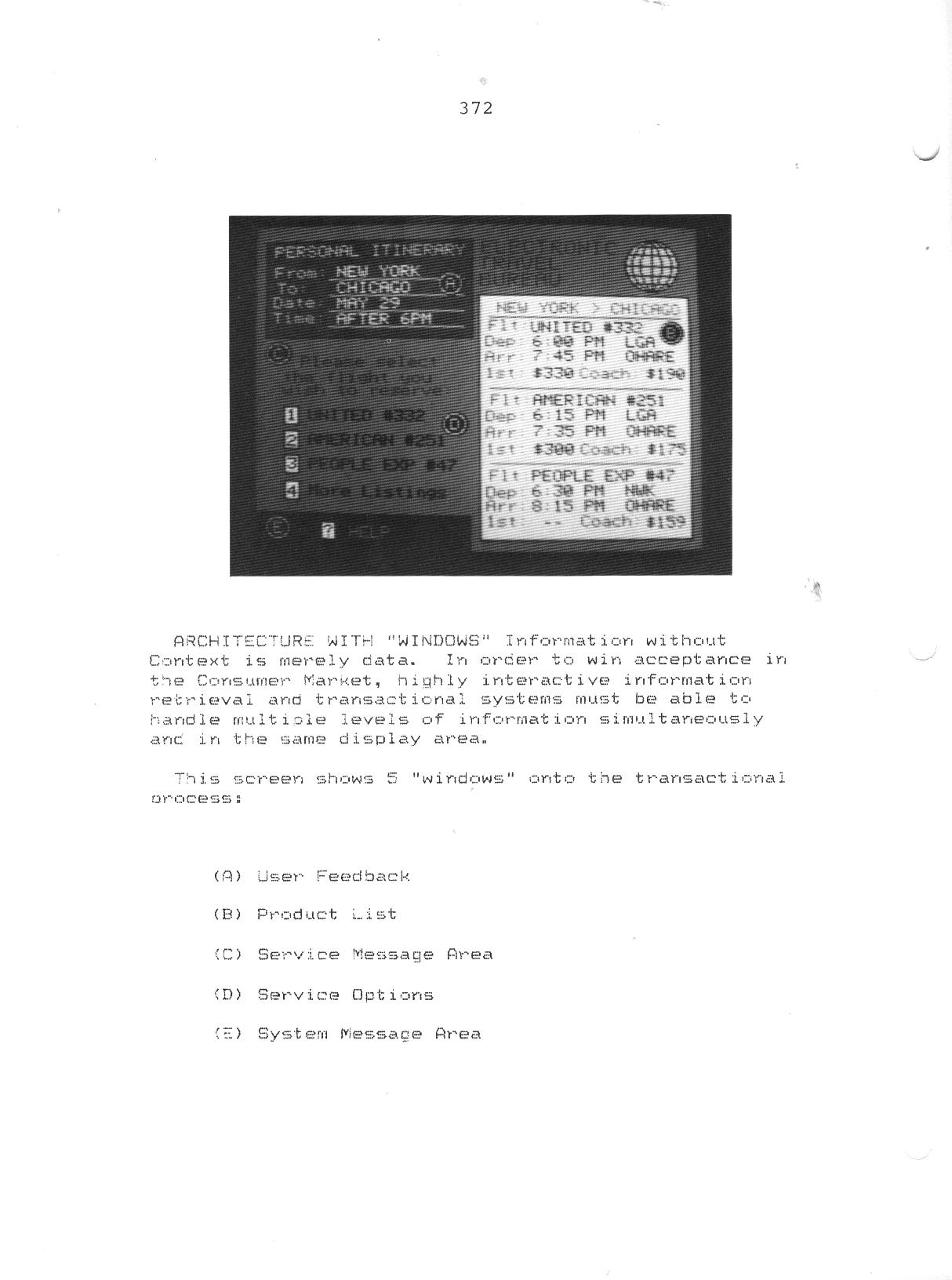
Standard Symbology
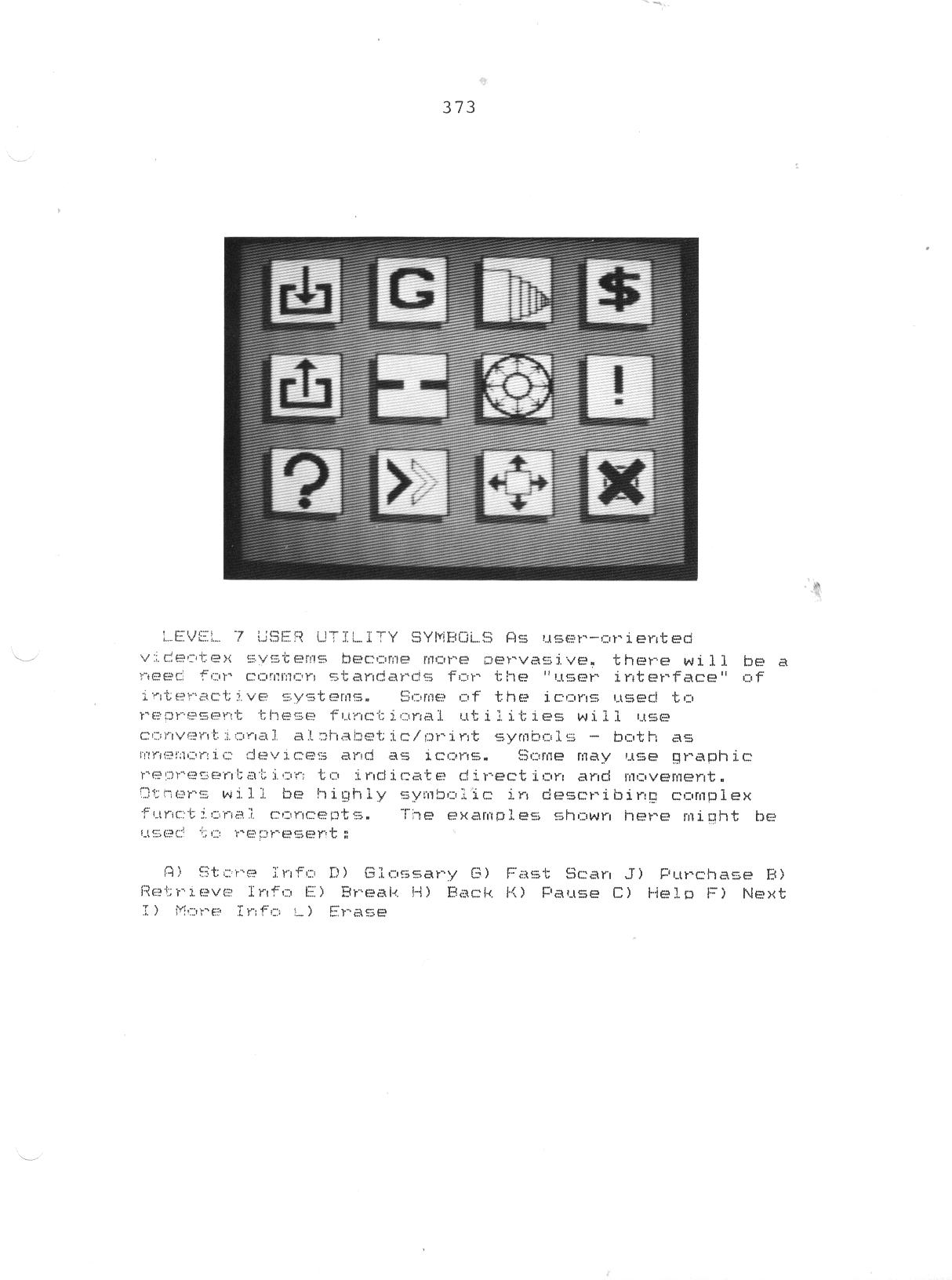
Tagging: The Rosetta Stone
